Is Planet Labs another victim of Roscosmos' record launch?
In recent days, the media began to raise the topic of a record launch for Russia on July 14, 2017, when the Fregat upper stage put 73 satellites into orbit. At the same time, many vehicles were out of order then, but Roskosmos persistently declares its non-participation in accidents. However, the American company, which had lost its satellites at that time, was paid insurance after the Russian side provided them with the Frigate telemetry, from which it appeared that it was the reason for the satellites to fail.
Most of the satellites (48) of this launch belong to the Planet company, and it became interesting to me to see if everything is in order. Previously, no one paid attention to them, because the company itself is silent about their fate, but, as it turns out, there is enough open data to investigate. And after that, there is no doubt that many more people are experiencing problems than they are now writing in the media.
To begin with, Planet (formerly Planet Labs) now has more than 250 cubic meters in orbit, which allow it to photograph the entire land surface every day. At the same time, almost the entire volume of each small satellite is occupied by optics, and they have no engine. Fortunately, human inventiveness is limited only by the laws of nature, and there is a way to influence the orbits of satellites even without a propulsion system.
The fact is that, firstly, they all fly in low orbits (maximum 600 km), and secondly, they have folding solar panels. And this means that, turning the satellite with different sides to the direction of movement, you can influence the air resistance, which at this height is, of course, very thin, but it is still slightly felt.
')

Of course, the satellite includes a control system that allows it to be rotated in the right direction, and it turns out that with its help you can control the speed of its decrease (the greater the air resistance, the faster the satellite decreases). And the orbital period depends on the height of the orbit (in other words, the angular velocity). The lower the satellite, the smaller its period, the greater the angular velocity.
Dove satellites (“Dove”, as they are called) launch several units on one rocket at once (the record is 88 at a time). A group of such simultaneously running devices is called Flock (“Flock”). The orbits of all satellites from the same “flock” are in the same plane. Therefore, the main task is to evenly distribute the satellites of each “flock” in the plane of their orbit:
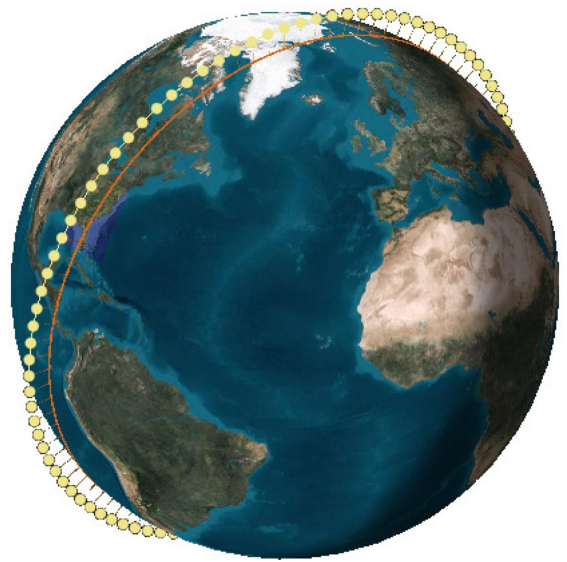
For this, the circle is divided into equal parts - slots - and each satellite is assigned its own slot. At the same time, immediately after launch, all the satellites are close to each other, because they are separated from one rocket, so there are two stages: breeding satellites in their slots and maintaining the position of each satellite in its slot. And here we remember the angular velocity. It depends on the height, and the rate of change in height can be influenced by the orientation of the apparatus.
In this case, the height of all the devices was originally different due to the fact that they are separated from the rocket in different ways, and small variations in the height of the resulting satellite orbit depend on the speed and direction of separation. And the thing is that the space-track.org service allows for each near-earth satellite to obtain data on its orbit updated about once a day (both the current orbit and all previous measurements). So we can see how the orbits of the Planet satellites launched on that rocket behaved and how they were distributed along their orbital plane.
Immediately, I’ll make a reservation that one of the 48 Dove satellites turned out to be in a different orbit (it was separated ahead of time), while the other satellite (Lemur) was in orbit where that Dove was supposed to be (Lemur separated after its time). That is, they seemed to swap places. Officially, nobody was able to explain it. At the same time, the Lemur works as it should, and Dove never got in touch, so we will consider only 47 devices.
Let's first consider the first month of the existence of satellites. If you take one of the devices and put on the schedule by day the positions of all the other satellites relative to it, you get the following visualization:
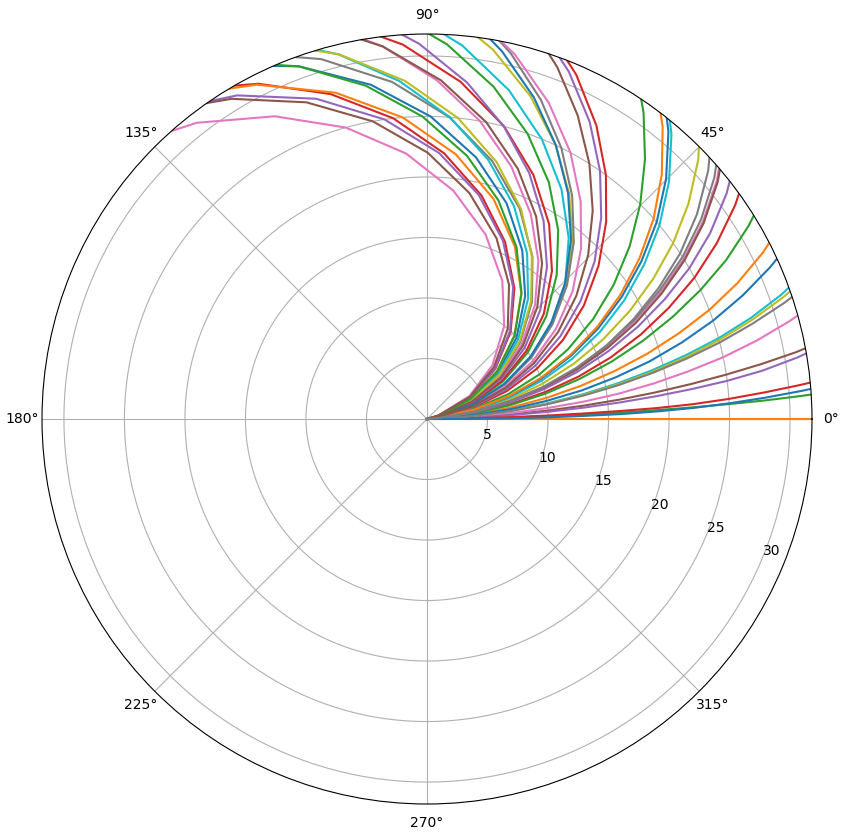
There are days along the radial axis (distance from the center), and it is clearly seen how over time the satellites crawl along the orbital plane. So far, so good. Let's now look at a graph of satellite heights for the first 130 days.
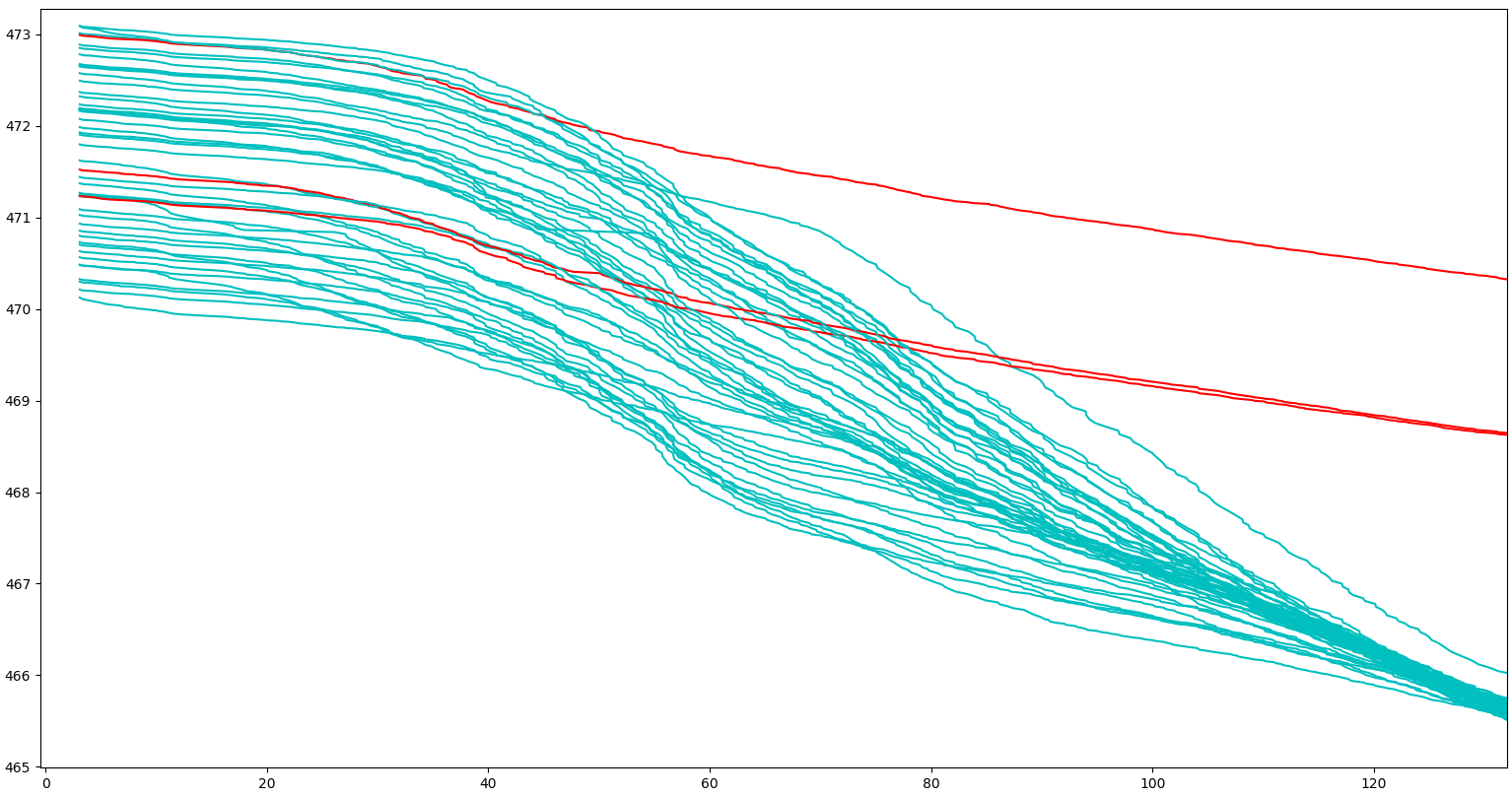
As we see, all the satellites were controlled down to the same height, except for three. These three satellites decrease more slowly than others, because they do not use the braking method described above. So, they quickly lost the ability to maintain orientation. On the distribution graph on the plane, this is also clearly visible:
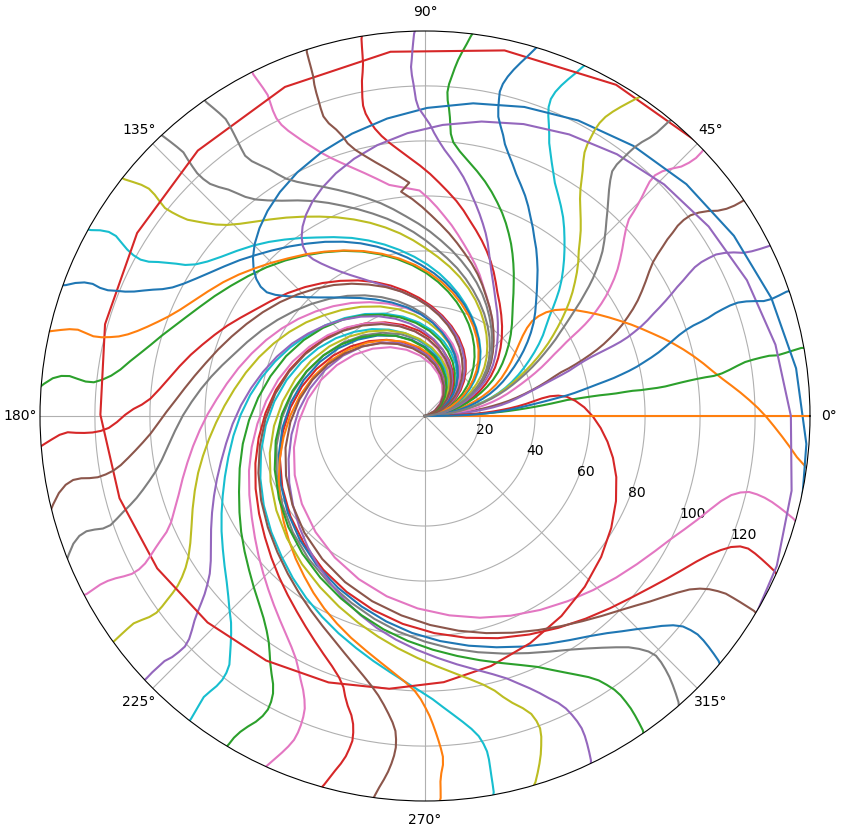
We see that all the devices over these 130 days have occupied their slots, and three (red, blue and purple) fly uncontrollably all over the plane. Since they are higher than the others, their angular velocity is lower, so they lag behind the other satellites, as we see on the graph. Another satellite (red line) also behaves unusually, but according to the height chart, we see that it retains the ability to brake and is controlled in a slot just below 0 degrees.
So, somewhere in 45-50 days after the launch, three of the 47 satellites completely lost the ability to maintain orientation. In other words, out of order. In the next graph, I will exclude these devices, so as not to clutter up the picture. And the picture today turns out this:
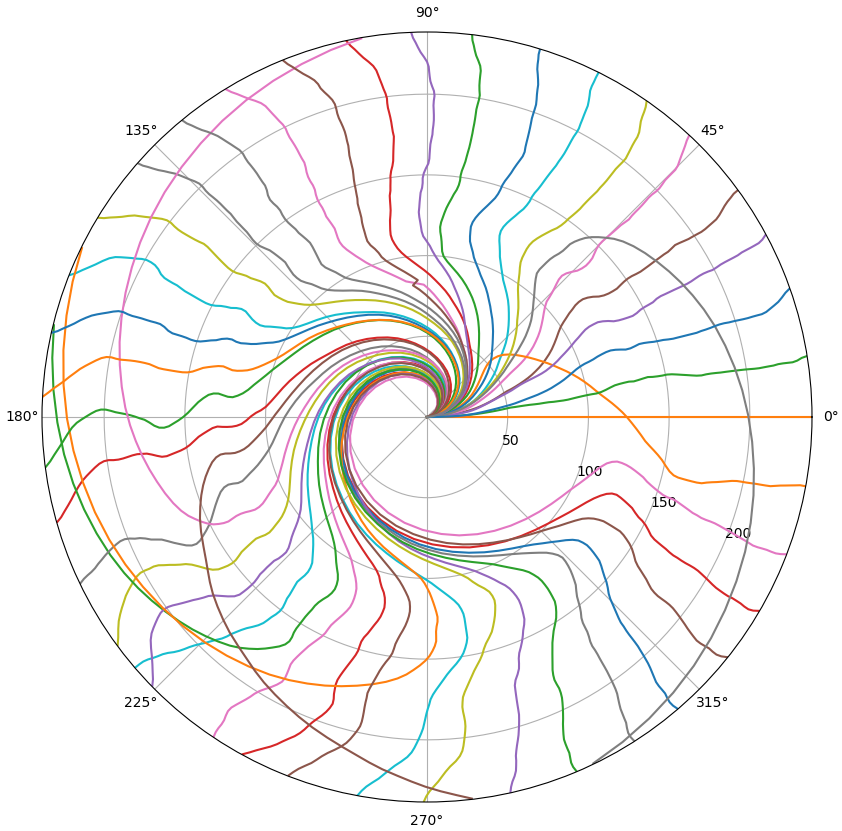
As you can see, somewhere around 140 days, three more vehicles were carried along the orbital plane (gray, red and pink), and about 165 days they were joined by another one (green). In addition, the strange movement of another satellite (brown) catches the eye. The height chart shows that it did not fall behind, but, on the contrary, began to decline faster than others:
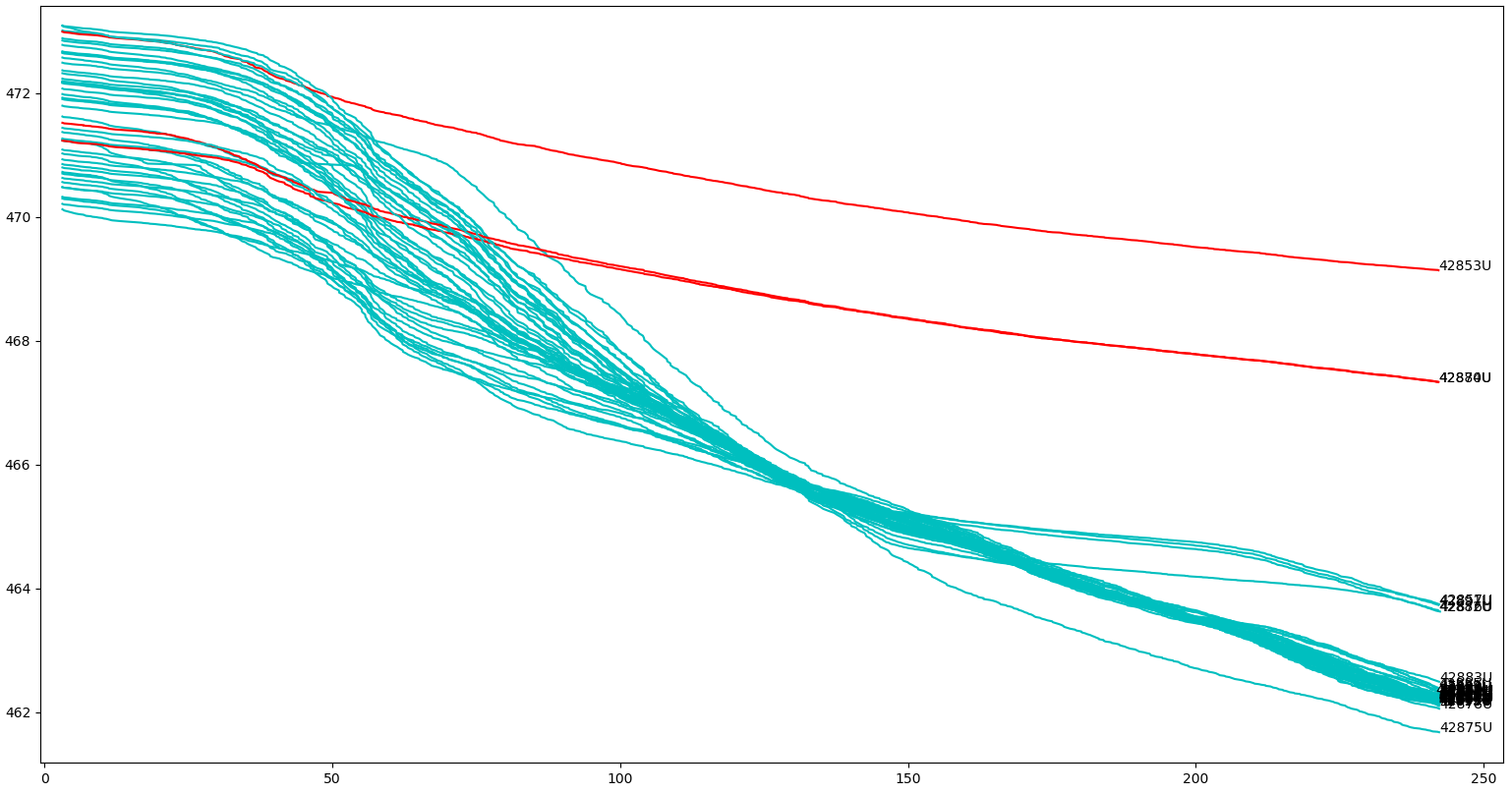
The reasons for this decline can not be exactly say anything. On the one hand, Planet could decide to sharply send this unit to another slot. On the other hand, he was already part of a site with an excellent distribution of apparatuses, and I see no reason that would force him to clean it from there. The device could fail, being at the same time in the "braking" orientation.
As for those four lost satellites, you can see on the height chart that at one moment they still changed orientation and began to decline faster, but still they hardly function normally. All of them were perfectly positioned in their slots, and they left there obviously not from a good life. Probably, these satellites are not dead, but they are not fully functional either.
It is interesting to compare this chart with the two previous Planet launches:
So, at the moment we have 4 out of 48 vehicles 4 dead and 5 more obviously not quite healthy.
Thus, the list of failed devices can be expanded: MKAN x 2, Landmapper x 2, Lighthouse, Ecuador, Spark, Cicero x 3, Dove x 4. These are 14 failed machines, plus Lemur 2 Artfischer not in its own orbit, plus 5 more Dove satellites are unhealthy 4-5 months after launch.
An incident analysis from the crew of the satellite Mayak concluded that there could be a hydrazine leak on the Frigate. This version was later confirmed by the media, and Roscosmos admitted that an anomaly had happened to one of the engines. True, the official position insists that this “anomaly” was recorded after the separation of the group of Kubsats, in which there were many failures, therefore Roscosmos does not recognize its guilt. According to official statements, the engine malfunction was recorded at 11440 minutes of flight, that is, after about 3 hours. But the fact is that the Dove satellites were just separated much later, at the eighth hour of flight, so that they could be affected by the resulting hydrazine.
And this version may well explain the anomalies with the Planet satellites. The fact is that when hydrazine gets onto the solar panels, they begin to gradually degrade and eventually give less and less energy. Accordingly, the more hydrazine they get, the worse. According to this version, the first three devices were unlucky, and after 50 days they were not able to provide themselves with electricity.
I must say, most likely, the same thing happened with two Landmapper satellites. Astro Digital, their developer, wrote a month and a half after the launch that the connection with the devices was initially, but later disappeared. As for the remaining 5 Dove satellites, if they are unhealthy, then this may have a similar reason: degradation of solar panels. But not as serious as the first three satellites, which allowed them to last longer. However, it is worth noting that the causes of problems may be others.
Materials:
arxiv.org/abs/1509.03270
arc.aiaa.org/doi/abs/10.2514/1.A33927
www.space-track.org
spacenews.com/additional-cubesats-on-july-14-soyuz-flight-are-unresponsive
blog.astrodigital.com/not-nominal-we-lost-2-satellites-23e771a4bc8b
www.gazeta.ru/science/2018/03/12_a_11679697.shtml
tass.ru/kosmos/5032458
Most of the satellites (48) of this launch belong to the Planet company, and it became interesting to me to see if everything is in order. Previously, no one paid attention to them, because the company itself is silent about their fate, but, as it turns out, there is enough open data to investigate. And after that, there is no doubt that many more people are experiencing problems than they are now writing in the media.
Planet and their satellites
To begin with, Planet (formerly Planet Labs) now has more than 250 cubic meters in orbit, which allow it to photograph the entire land surface every day. At the same time, almost the entire volume of each small satellite is occupied by optics, and they have no engine. Fortunately, human inventiveness is limited only by the laws of nature, and there is a way to influence the orbits of satellites even without a propulsion system.
The fact is that, firstly, they all fly in low orbits (maximum 600 km), and secondly, they have folding solar panels. And this means that, turning the satellite with different sides to the direction of movement, you can influence the air resistance, which at this height is, of course, very thin, but it is still slightly felt.
')

Of course, the satellite includes a control system that allows it to be rotated in the right direction, and it turns out that with its help you can control the speed of its decrease (the greater the air resistance, the faster the satellite decreases). And the orbital period depends on the height of the orbit (in other words, the angular velocity). The lower the satellite, the smaller its period, the greater the angular velocity.
Dove satellites (“Dove”, as they are called) launch several units on one rocket at once (the record is 88 at a time). A group of such simultaneously running devices is called Flock (“Flock”). The orbits of all satellites from the same “flock” are in the same plane. Therefore, the main task is to evenly distribute the satellites of each “flock” in the plane of their orbit:

For this, the circle is divided into equal parts - slots - and each satellite is assigned its own slot. At the same time, immediately after launch, all the satellites are close to each other, because they are separated from one rocket, so there are two stages: breeding satellites in their slots and maintaining the position of each satellite in its slot. And here we remember the angular velocity. It depends on the height, and the rate of change in height can be influenced by the orientation of the apparatus.
In this case, the height of all the devices was originally different due to the fact that they are separated from the rocket in different ways, and small variations in the height of the resulting satellite orbit depend on the speed and direction of separation. And the thing is that the space-track.org service allows for each near-earth satellite to obtain data on its orbit updated about once a day (both the current orbit and all previous measurements). So we can see how the orbits of the Planet satellites launched on that rocket behaved and how they were distributed along their orbital plane.
Immediately, I’ll make a reservation that one of the 48 Dove satellites turned out to be in a different orbit (it was separated ahead of time), while the other satellite (Lemur) was in orbit where that Dove was supposed to be (Lemur separated after its time). That is, they seemed to swap places. Officially, nobody was able to explain it. At the same time, the Lemur works as it should, and Dove never got in touch, so we will consider only 47 devices.
What happened
Let's first consider the first month of the existence of satellites. If you take one of the devices and put on the schedule by day the positions of all the other satellites relative to it, you get the following visualization:

There are days along the radial axis (distance from the center), and it is clearly seen how over time the satellites crawl along the orbital plane. So far, so good. Let's now look at a graph of satellite heights for the first 130 days.

As we see, all the satellites were controlled down to the same height, except for three. These three satellites decrease more slowly than others, because they do not use the braking method described above. So, they quickly lost the ability to maintain orientation. On the distribution graph on the plane, this is also clearly visible:

We see that all the devices over these 130 days have occupied their slots, and three (red, blue and purple) fly uncontrollably all over the plane. Since they are higher than the others, their angular velocity is lower, so they lag behind the other satellites, as we see on the graph. Another satellite (red line) also behaves unusually, but according to the height chart, we see that it retains the ability to brake and is controlled in a slot just below 0 degrees.
So, somewhere in 45-50 days after the launch, three of the 47 satellites completely lost the ability to maintain orientation. In other words, out of order. In the next graph, I will exclude these devices, so as not to clutter up the picture. And the picture today turns out this:

As you can see, somewhere around 140 days, three more vehicles were carried along the orbital plane (gray, red and pink), and about 165 days they were joined by another one (green). In addition, the strange movement of another satellite (brown) catches the eye. The height chart shows that it did not fall behind, but, on the contrary, began to decline faster than others:

The reasons for this decline can not be exactly say anything. On the one hand, Planet could decide to sharply send this unit to another slot. On the other hand, he was already part of a site with an excellent distribution of apparatuses, and I see no reason that would force him to clean it from there. The device could fail, being at the same time in the "braking" orientation.
As for those four lost satellites, you can see on the height chart that at one moment they still changed orientation and began to decline faster, but still they hardly function normally. All of them were perfectly positioned in their slots, and they left there obviously not from a good life. Probably, these satellites are not dead, but they are not fully functional either.
It is interesting to compare this chart with the two previous Planet launches:
Comparison
Planet's record launch of 88 devices at a time:

Several vehicles are knocked out of the general group, but far from as much as the first three of our launch. Another earlier launch:

It can be seen that many devices were also beaten out, but in the end they all came together. So, this behavior of the first three satellites is clearly knocked out.

Several vehicles are knocked out of the general group, but far from as much as the first three of our launch. Another earlier launch:

It can be seen that many devices were also beaten out, but in the end they all came together. So, this behavior of the first three satellites is clearly knocked out.
So, at the moment we have 4 out of 48 vehicles 4 dead and 5 more obviously not quite healthy.
Thus, the list of failed devices can be expanded: MKAN x 2, Landmapper x 2, Lighthouse, Ecuador, Spark, Cicero x 3, Dove x 4. These are 14 failed machines, plus Lemur 2 Artfischer not in its own orbit, plus 5 more Dove satellites are unhealthy 4-5 months after launch.
Possible reasons
An incident analysis from the crew of the satellite Mayak concluded that there could be a hydrazine leak on the Frigate. This version was later confirmed by the media, and Roscosmos admitted that an anomaly had happened to one of the engines. True, the official position insists that this “anomaly” was recorded after the separation of the group of Kubsats, in which there were many failures, therefore Roscosmos does not recognize its guilt. According to official statements, the engine malfunction was recorded at 11440 minutes of flight, that is, after about 3 hours. But the fact is that the Dove satellites were just separated much later, at the eighth hour of flight, so that they could be affected by the resulting hydrazine.
And this version may well explain the anomalies with the Planet satellites. The fact is that when hydrazine gets onto the solar panels, they begin to gradually degrade and eventually give less and less energy. Accordingly, the more hydrazine they get, the worse. According to this version, the first three devices were unlucky, and after 50 days they were not able to provide themselves with electricity.
I must say, most likely, the same thing happened with two Landmapper satellites. Astro Digital, their developer, wrote a month and a half after the launch that the connection with the devices was initially, but later disappeared. As for the remaining 5 Dove satellites, if they are unhealthy, then this may have a similar reason: degradation of solar panels. But not as serious as the first three satellites, which allowed them to last longer. However, it is worth noting that the causes of problems may be others.
Materials:
arxiv.org/abs/1509.03270
arc.aiaa.org/doi/abs/10.2514/1.A33927
www.space-track.org
spacenews.com/additional-cubesats-on-july-14-soyuz-flight-are-unresponsive
blog.astrodigital.com/not-nominal-we-lost-2-satellites-23e771a4bc8b
www.gazeta.ru/science/2018/03/12_a_11679697.shtml
tass.ru/kosmos/5032458
Source: https://habr.com/ru/post/410887/
All Articles